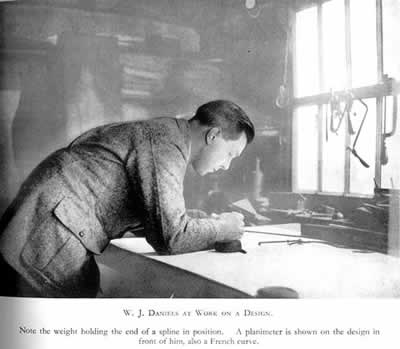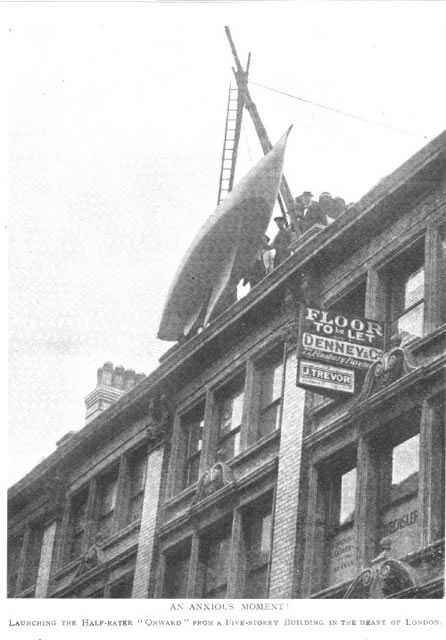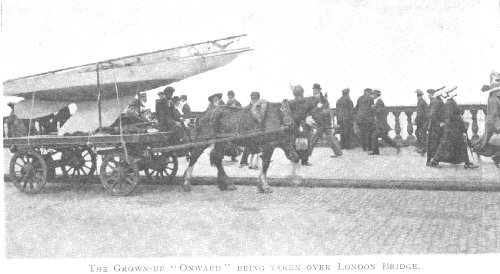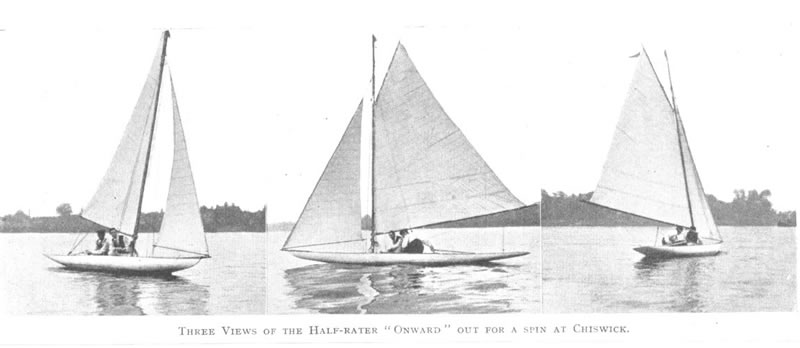|
Note: the symbol  denotes
a footnote in the source document. Hover over the symbol and the note
will pop-up. denotes
a footnote in the source document. Hover over the symbol and the note
will pop-up.
William John "Bill" Daniels was born on the 4th February 1882 at 45 Spencer Street Clerkenwell, East London. Philip Leigh, who
knew him well from the 1920s until Daniel's death in 1959, had the idea that in his youth he had in some
way been connected with the design of one of the pubs that stand on
Cambridge Circus in London, but I have not been able to find any confirmation
of this. If he was involved, it is possible that he was employed as
a draughtsman in an architectural practice. In the 1930s he was responsible
for the design of the large and elaborate wooden clubhouse built for
the YM6MOA at the Rick Pond, Hampton Court.

Though he must have been active before this date,
he first becomes visible in model yachting with the production of the
design for the 10-rater XPDNC in 1905-6. This boat is
immensely important in the history of model yachting as it is the boat
on which Daniels developed his system of calculated hull balance. The
idea was to shape the boat so that the CB did not move fore and aft
when the boat was heeled. This eliminated the steering tendency that
would otherwise occur as the boat trimmed by the head or stern when
heeled  He was very successful with this boat, winning the Surbiton Club's Coronation Shield, described as the "Blue Riband" of London Model Yachting, and
other major London competitions in the 1906 season.
He was very successful with this boat, winning the Surbiton Club's Coronation Shield, described as the "Blue Riband" of London Model Yachting, and
other major London competitions in the 1906 season. 
In the Model Engineer report of the
Coronation Shield race the design is attributed to W J Richards, a fellow
member of the Highgate club and in other sources it is credited to 'Richards
and Daniels'.
Daniels eventually wrote an account of the development process in M.E.
in 1915 which makes it very clear that the design and development were
all his own. He describes how he tried five different fin forms and
fifteen variations of rig before recognising that it was the design
of the hull that was critical. Philip Leigh passed on the information
that some of the fin variation was performed on the side of the pond
with a fret saw. This may have to be taken with a pinch of salt as he
didn't meet Daniels until nearly 20 years after the event.
In 1909 Richards and Daniels formed a partnership as professional designers and builders of model yachts, "Richards and Daniels" at 45 Hatton Garden, London EC. However, this partnership was short lived because Richards died of pneumonia on 3rd March 1910. Entries in the relevant street directories suggest that Danials continued in business as "Richards and Daniels" until at least 1911.
In 1910 Daniels designed a development of XPDNC
called Onward. With this boat he again won the Surbiton Club's Coronation Shield. He wrote the
report of the race and illustrated it with his own photos, making sure
that all the readers knew what a fine boat she was and what a pre-eminent
designer and skipper he was. In that season Onward won
21 events in 23 starts in and around London. The following year the
event was won by a South London MYC boat Chum, an Onward
clone. Phillip Leigh described the London scene immediately
after the 1914 war as filled with Onward copies and
'improvements'. There is no doubt that Daniels concepts set the
form for 10-rater design for the next twenty years or more. By 1913, and until 1916, Daniels was in business on his own account as a model yacht designer and builder
at 66 Fore Street, London EC and was already widely regarded as the premier
skipper of his generation.
His business must have been doing quite well for
in 1913 he built himself a full size keel boat, a half rater to the
LSA rule that was closely based on the design of Onward.
This was the occasion of H B Tucker's first meeting with Daniels: he
was passing as the boat was being lowered out of Daniels' third floor
workshop onto a horse lorry to be conveyed to the Thames at Westminster
pier.


It is a sign of Daniels' great confidence in his
boat (and in himself) that, having taken to the water, his first outing
was to sail her single handed down the Thames, through the immensely
busy Pool of London, to the River Lea where he intended to keep her.
This suggests that there must have been sailing activity on the Lea
(or more probably on the reservoirs in the Lea valley) and that Daniels
was still living in East London
Later he sailed this boat on the Welsh Harp reservoir in North London,
when he was living close enough to the water for his wife to hang a
sheet out of the bedroom window to summon him home for lunch.

Also in 1913, Daniels led the British
team in the first seriously organised international model yacht race
which took place against French and Belgian teams on a lake at Enghien-les
Bains, a spa on the northern outskirts of Paris. This was a venture
encouraged and subsidised by Wenman J Bassett-Lowke, who had genuinely
internationalist aspirations as well as hopes of increasing the Continental
reach of his up-market model engineering business. The Model Yacht Racing
Association (MYRA, formed in 1911), at that time embraced both powered
and sailing models and there was a parallel competition for power craft,
but on the day, only the British were able to field a team. The main
sailing match was run with boats to the Continental 80-cm Rule. This
was essentially a slight variant from the International Rule of 1906,
but because the rating limit was 80cm, rather than 1 metre as was the
case in Britain, the boats were a good deal smaller, typically 32-34
inches overall and 10-15 pounds displacement. The racing was run from
pontoons on a large lake and the racing area was edged with netting.
Mid course adjustments were made by following the boats in rowing skiffs.
In the formal international match for teams of three, run in a near
calm and heavy rain, the British boats scored a maximum with the French
a distant second.
By this time Daniels was on the Council of the MYRA:
it isn't possible to be sure whether he was involved in its foundation
as there is no record of its activity before a report in ME
of its second AGM. No MYRA records have survived. He was also playing
a leading role in magazine controversies over the merits of various
Rating Rules and the role of the professional in the sport. In 1913
he was chosen by Percival Marshall to write a new version of Marshall's
Model Sailing Yachts. Originally published in 1905, with
a text mainly written by H Wilson Theobald, the book had been overtaken
by developments in the sport in the intervening years, many of which
stemmed directly from Daniels' own work. The new text remained in print,
almost unchanged, until the 1950s and had a huge influence. Among other
things, it established Daniel's building methods as the effective standard
for as long as wooden boats were the norm.
Danels enlisted in the Royal Naval Air Service. on 27th March 1916, Service Number F12741. He under went training to become a Leading Air Mechanic/Hydrogen Worker. On 1st August 1917 he was promoted to Petty Officer Mechanic/Hydrogen Worker and posted to the airship station RNAS Longside near Aberdeen. On 11th January 1918, he was posted to the airship station RNAS Pulham in Norfolk. The Royal Naval Air Service and Royal Flying Corps became the independent Royal Air Force from 1st April 1918 and Daniels rank changed to Sergeant Mechanic/Hydrogen Worker and his service number changed to 212741. On 11th April 1919 he was posted to Crystal Palace (then being used as a large de-mobilisation centre) and he was discharged on 30th April 1920.
Daniels war record can be found in files ADM 188/584 and AIR 79 at the National Record Centre, Kew.
After the war model yachting took some time to re-establish
itself and little seems to have happened before MYRA went through a
major restructuring in 1923 to separate off the power modellers and
become the Model Yachting Association (MYA). Meanwhile Daniels had not
been idle. Seeking to attract publicity to the sport and to himself
and using contacts he had made with Malden Heckstall-Smith, then the
editor of Yachting Monthly, he conceived the idea of issuing
a challenge to American model yachtsmen for a match to be sailed in
the US. After a lot of correspondence it was agreed that the match would
be sailed in B Class boats to the American Rule and to American sailing
rules for open water, with the models being handled from skiffs. The
match eventually took place in June of 1922 in Little Neck Bay on the
north shore of Long Island. For this Daniels and his wife Letitia traveled to America on the White Star Line's, "Olympic", sister to the "Titanic". Daniels' Endeavour was comprehensively
defeated by E J Bull's Polka Dot. The racing was
something of a farce with drifting matches influenced by tidal streams
and heavy wash from motor boats out in the bay, gear failures and, amazingly,
Daniels' failure to master either the Rules or the techniques of skiff
sailing. These aspects of this seminal meeting were written out of all
accounts of it that appeared after Daniels' own report in Yachting
Monthly.
Nothing daunted, Daniels next sought to establish
a new international competition for a large model built to a new Rule,
which would be sponsored by YM. This fell in conveniently
with Heckstall-Smith's desire to promote an alternative Rule to replace
the International Rule 6-metre, which he regarded as unsuitable for
an open keelboat  His idea was that the model competition would promote the ideas behind
the new Rule and lead eventually to the building of full size boats
to challenge the IR 6-metre. In the event no full size boats were ever
built to the Rule, though the 5.5 metre class, introduced after the
Second World War, has a Rule that shares many elements with that devised
for models in 1922.
His idea was that the model competition would promote the ideas behind
the new Rule and lead eventually to the building of full size boats
to challenge the IR 6-metre. In the event no full size boats were ever
built to the Rule, though the 5.5 metre class, introduced after the
Second World War, has a Rule that shares many elements with that devised
for models in 1922.
The Rule devised by Heckstall-Smith, possibly with
some assistance from Daniels, owed something to the 18 footer BRA rule
of 1914, which Heckstall-Smith had championed but to little effect among
full size yachtsmen. It owed more to the American Universal Rule, importing
the basic structure of the Rule, with length and the root of the sail
area on the top line and displacement on the bottom. The method of measuring
length on the quarter beam was also a direct import, as was the concept
of penalising, rather than forbidding, deviations from what were regarded
at the time as desirable proportions of elements. This form of Rule
which plays sail area against length, but allows additional sail as
displacement increases, allows for wide ranging experiment and permits
boats of different concept to sail against each other. It also gives
a Rule that has been able to accommodate major advances in materials
technology, particularly in sail materials, without calling for changes
to the Rule.
Initially the YM6m was not an MYA Class, and there
was some division of opinion among model yachtsmen over whether this
was really the best way forward. However the MYA agreed to run the annual
competitions for the British Empire championship and the international
matches in which foreign boats sailed against the Empire champion. The
first competition, held at Gosport in 1923 attracted only 12 boats and
one foreign challenge, Dana, a boat owned by E V Graae
and built and sailed by Charles Tottrup  . Both were UK resident Danes. Graae was part owner of a full size yacht
on the Solent and Tottrup was a North London modeller, who, among other
things, built class model yachts to order to be sold by Bassett-Lowke.
Daniels sailed Invader, a boat he had designed and built
for F Scott Freeman, a Staines solicitor and noted up-river helmsman
on the Thames
. Both were UK resident Danes. Graae was part owner of a full size yacht
on the Solent and Tottrup was a North London modeller, who, among other
things, built class model yachts to order to be sold by Bassett-Lowke.
Daniels sailed Invader, a boat he had designed and built
for F Scott Freeman, a Staines solicitor and noted up-river helmsman
on the Thames  .
.
 |
|
Crusader 1925
|
Daniels won the Empire championship
narrowly from George Braine's Mary, but went on to comprehensively
defeat the Danish boat. This pattern was repeated in1924 when Daniels
sailed Scott Freeman's Crusader and again beat a Danish
challenger, sailed by Tottrup. In 1925 the first true overseas challenger
appeared, when Joe Weaver brought Slipper over from
the US. This was not a boat designed to the YM6m Rule but an American
B Class boat re-measured. Daniels again sailed Crusader
and won the Empire championship after a close fight with Arberry's
Dayspring, a boat to his own Invader lines.
He went on to win the international races easily, securing the cup
outright for Scott Freeman. Everything might have ended there had
not Yachting Monthly agreed to put up another cup. This
time they took care to make it a perpetual challenge trophy.
-
More next time
Russell Potts
Page updated 28 August 2015
|
